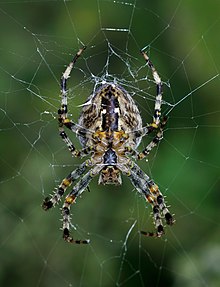
Summary
The Entelegynae or entelegynes are a subgroup of araneomorph spiders, the largest of the two main groups into which the araneomorphs were traditionally divided. Females have a genital plate (epigynum) and a "flow through" fertilization system; males have complex palpal bulbs. Molecular phylogenetic studies have supported the monophyly of Entelegynae (whereas the other traditional subgroup, the Haplogynae, has been shown not to be monophyletic).[1]
| Entelegynae Temporal range:
| |
|---|---|

| |
| Underside of Araneus diadematus showing epigynum | |
| Scientific classification | |
| Domain: | Eukaryota |
| Kingdom: | Animalia |
| Phylum: | Arthropoda |
| Subphylum: | Chelicerata |
| Class: | Arachnida |
| Order: | Araneae |
| Infraorder: | Araneomorphae |
| Clade: | Entelegynae Simon, 1893 |
| Families | |
|
Unnamed clade
Unnamed clade
Incertae sedis: | |
The clade contains both cribellate and ecribellate spiders.
Characterization edit
The Entelegynae are characterized primarily by the nature of the female genital system. The ancestral (plesiomorphic) system is found in non-entelegyne spiders, where there is a single external genital opening in the female's abdomen. One or more males inject sperm from their palpal bulbs via this opening; the sperm is usually stored in special spermathecae (absent in some spiders, e.g. Pholcus). When eggs are released from the ovaries, sperm is also released, and the fertilized eggs pass out of the female's body by the same opening. Sperm that enters first is likely to be the last to fertilize eggs.[2][1][3]
In entelegyne spiders, there are three external openings in the female's body. Sperm is injected via one or other of the two separate copulatory openings and enters the spermathecae. Egg release and fertilization occurs in the same way as in non-entelegyne spiders. In this "flow through" system, sperm that enters first can be the first to fertilize eggs.[2][1][3]
The copulatory openings are usually surrounded by a hardened (sclerotized) area called the epigynum. In some entelegyne families, such as araneids, the epigynum includes a projection that covers or partially covers the copulatory openings. This plays a role in aligning the male's palpal bulb during mating.[2] Male entelegyne spiders generally have more complex palpal bulbs than other groups of spiders and the bulbs are expanded and moved by haemolytic pressure alone, as there are no muscles attached to them.[4]
Phylogeny edit
In 2016, a large molecular phylogenetic study was published online that included 932 spider species, representing all but one of the then known families. It supported the monophyly of Entelegynae, but presented a somewhat complex picture of its position within Araneomorphae. Araneomorph spiders were divided into two clades: one comprising the families Filistatidae and Hypochilidae plus the clade Synspermiata, the other comprising three non-monophyletic families (Austrochilidae, Gradungulidae and Leptonetidae) plus Palpimanoidea, the four being basal to Entelegynae.[1]
| Araneomorphae |
| ||||||||||||||||||||||||||||||
Most members of the former Haplogynae are placed in the Synspermiata. Filistatidae is placed outside the Synspermiata; Leptonetidae, which was found not to be monophyletic, is placed basal to the Entelegynae.[1]
Families edit
The cladogram in Wheeler et al. (2017) includes the following families in the Entelegynae. The main difference from previous circumscriptions, such as Coddington in 2005,[5] is that the Palpimanoidea are excluded. A few groups within otherwise entelegyne families have reverted to a haplogyne state: the genera Comaroma, Tangaroa and Waitkera, and some members of the family Tetragnathidae.[1]
- Agelenidae
- Amaurobiidae
- Ammoxenidae
- Anapidae
- Anyphaenidae
- Araneidae
- Arkyidae
- Cheiracanthiidae (syn. Eutichuridae)
- Cithaeronidae
- Clubionidae
- Corinnidae
- Ctenidae
- Cyatholipidae
- Cybaeidae
- Cycloctenidae
- Deinopidae
- Desidae
- Dictynidae
- Eresidae
- Gallieniellidae
- Gnaphosidae
- Hahniidae
- Hersiliidae
- Homalonychidae
- Lamponidae
- Linyphiidae
- Liocranidae
- Lycosidae
- Malkaridae
- Megadictynidae
- Mimetidae
- Miturgidae
- Mysmenidae
- Nesticidae
- Nicodamidae
- Oecobiidae
- Oxyopidae
- Penestomidae
- Philodromidae
- Phrurolithidae
- Physoglenidae
- Phyxelididae
- Pimoidae
- Pisauridae
- Psechridae
- Salticidae
- Selenopidae
- Senoculidae
- Sparassidae
- Stiphidiidae
- Symphytognathidae
- Synotaxidae
- Tetragnathidae
- Theridiidae
- Theridiosomatidae
- Thomisidae
- Titanoecidae
- Toxopidae
- Trachelidae
- Trechaleidae
- Trochanteriidae
- Udubidae
- Uloboridae
- Viridasiidae
- Xenoctenidae
- Zodariidae
- Zoropsidae
No representative of the family Synaphridae was included in the 2017 analysis,[1] but previous analyses placed it in the Entelegynae.[5]
References edit
- ^ a b c d e f g Wheeler, Ward C.; Coddington, Jonathan A.; Crowley, Louise M.; Dimitrov, Dimitar; Goloboff, Pablo A.; Griswold, Charles E.; Hormiga, Gustavo; Prendini, Lorenzo; Ramírez, Martín J.; Sierwald, Petra; Almeida-Silva, Lina; Alvarez-Padilla, Fernando; Arnedo, Miquel A.; Benavides Silva, Ligia R.; Benjamin, Suresh P.; Bond, Jason E.; Grismado, Cristian J.; Hasan, Emile; Hedin, Marshal; Izquierdo, Matías A.; Labarque, Facundo M.; Ledford, Joel; Lopardo, Lara; Maddison, Wayne P.; Miller, Jeremy A.; Piacentini, Luis N.; Platnick, Norman I.; Polotow, Daniele; Silva-Dávila, Diana; Scharff, Nikolaj; Szűts, Tamás; Ubick, Darrell; Vink, Cor J.; Wood, Hannah M. & Zhang, Junxia (2017) [published online 2016], "The spider tree of life: phylogeny of Araneae based on target-gene analyses from an extensive taxon sampling", Cladistics, 33 (6): 574–616, doi:10.1111/cla.12182
- ^ a b c Foelix, Rainer F. (2011), Biology of Spiders (3rd p/b ed.), Oxford University Press, ISBN 978-0-19-973482-5
- ^ a b Uhl, Gabriele; Nessler, Stefan H. & Schneider, Jutta M. (2010), "Securing paternity in spiders? A review on occurrence and effects of mating plugs and male genital mutilation", Genetica, 138 (1): 75–104, doi:10.1007/s10709-009-9388-5
- ^ Huber, Bernhard A. (2004), "Evolutionary transformation from muscular to hydraulic movements in spider (Arachnida, Araneae) genitalia: A study based on histological serial sections", Journal of Morphology, 261 (3): 364–376, doi:10.1002/jmor.10255
- ^ a b Coddington, Jonathan A. (2005). "Phylogeny and classification of spiders" (PDF). In Ubick, D.; Paquin, P.; Cushing, P.E. & Roth, V. (eds.). Spiders of North America: an identification manual. American Arachnological Society. pp. 18–24. Retrieved 2015-09-24. p. 20.


